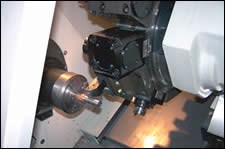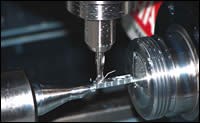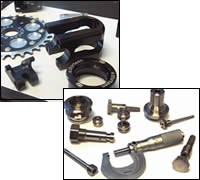A Fresh Face In Machining
It's late Friday night. While other 19-year-olds may be enjoying a movie or perhaps just hanging out with friends, Michael Goetz is programming a job on a mill-turn. The owner of Lombard, Illinois-based Goetz Industries is no stranger to hard work. In fact, in addition to completing coursework, he worked at least 50 hours per week while enrolled in high school.
Share




It’s late Friday night. While other 19-year-olds may be enjoying a movie or perhaps just hanging out with friends, Michael Goetz is programming a job on a mill-turn. The owner of Lombard, Illinois-based Goetz Industries (G.I.) is no stranger to hard work. In fact, in addition to completing coursework, he worked at least 50 hours per week while enrolled in high school.
When his counterparts were starting rock bands, Mr. Goetz was using his parents’ garage for another purpose—to make house wares and, eventually, bicycle components out of metal. What would compel a kid from the suburbs with no prior exposure or ties to machining to purchase a Mini Mill at 15, open a job shop at 17 and acquire a multitasking center at 18? How would the young entrepreneur be able to survive amidst more seasoned shop owners?
“Everything seems to start out with manufacturing,” Mr. Goetz says. “The economy begins at the machining center. Initially, I was interested in the amount of engineering that goes into them.”
With just three staff members comprising its workforce, G.I. soon found that just getting parts out the door was challenging. The shop has been able to do that—meeting production demands and adhering to tight tolerances—with a little help not only from its friends, but also from a Puma 1500SY mill-turn machine from Doosan Infracore (West Caldwell, New Jersey).
In 2003, a then 15-year-old Mr. Goetz purchased a Mini Mill from Haas Automation, Inc. (Oxnard, California). The ten-tool machine was appropriate for simple parts.
“Actually, I bought the Mini Mill because it was the only machine I could find that would run on the single-phase power normally found in residential areas,” he says
Early on, Mr. Goetz solicited guidance from a machine tool builder, subsequently consulting seasoned machinists in the area.
“I spent hours on the phone with a guy at Smithy [see below] to learn about the production environment,” Mr. Goetz says. “I didn’t know anyone involved in machining, so I needed someone to point me in the right direction. He answered all of my questions.”
The Goetz family basement later became home to a bench-top 3-in-1 lathe/mill/drill machine from Smithy Company (Ann Arbor, Michigan). Working from the bench-top CNC mill, he taught himself G code and 3D programming and started cutting parts the first day.
Once he mastered house wares, Mr. Goetz directed his focus to bicycle components, establishing G.I. in 2005, at which point he moved the business into a 1,300-square-foot facility, where it is still situated. Any business owner can attest to how daunting startup can be. For Mr. Goetz, the pressures were two-fold. Prohibited from holding legally binding contracts because of his age, Mr. Goetz had to pay for all of the tooling and materials for upcoming jobs in cash. Financing, among other things, could have been a nightmare were it not for the support of his family and the metalworking community.
Arthur Machinery (Elk Grove Village, Illinois) provided financing options for a Super VF2 three-axis machining center with fourth-axis programming from Haas and a Puma 240 turning center from Doosan Infracore. The distributor also assisted G.I. with the purchase of its Puma 1500SY mill-turn about 6 months ago.
“The company helped me when no one else would,” Mr. Goetz says.
At present, G.I. still does a fair amount of bike components, including levers, sprockets and cranks. However, it increasingly delves into small aerospace work and other lower-volume jobs for the mail sorting industry.
“After 1 1/2 years, I grew bored of solely producing aluminum bike components,” Mr. Goetz says. “I wanted to challenge myself.”
The company predominantly handles small to medium runs in the 100 to 2,000 pieces range, as well as prototypes and one-offs. The shop also accepts longer running contract jobs from time to time.
Stainless steel parts represent about 75 percent of the company’s business. G.I. also deals with high-temperature alloys for fuel injection components and other challenging parts, as well as a fair amount of titanium. Mr. Goetz characterizes a “big” turning part as one that is about 2 inches in diameter.
To minimize operating expenses, says Mr. Goetz, the company limits the extent to which it outsources. The only processes that G.I. does not perform are EDM, grinding, heat treat and coating.
Given the close proximity of an array of shops and tooling manufacturers, he also says G.I. has sought to differentiate itself. He sees the company’s strength not in numbers but is instead in fostering creativity to produce challenging, tight-tolerance parts economically.
To augment profit margins for its short-run and prototype work, the shop employs a Puma 1500SY to produce aerospace parts, such as fuel injection components and landing gear. According to Mr. Goetz, he initially gravitated toward mill-turn technology because of the promise of accelerated cycle times.
One fundamental principle of mill-turn technology is to unlock productivity potential that might have otherwise remained dormant by eliminating the downtime between milling and turning. Because multiple operations can be performed on one machine, space is conserved and accuracy is heightened. The user fixtures the part once or perhaps twice. Instead of being transferred to a separate machine to carry out multiple operations, the part remains on one machine. Therefore, concentricity (among other accuracy requirements) can be maintained. The accuracy is especially relevant to G.I., as the shop routinely holds dimensional tolerances to 0.0001 inch for parts entailing multiple machining processes.
Another potential benefit of using this type of machine is enabling “done-in-one” production while alleviating the slight line of delineation that results when a part is removed so that the opposite side may be turned. On this machine, the subspindle moves to the main spindle to pick off the part, and it then becomes the clamping spindle for subsequent machining operations. Also of interest, says Mr. Goetz, is the machine’s Y axis positioning
Despite the allure of the mill-turn, some shops may be reluctant to adopt the technology because of perceived challenges associated with programming all of the axes, says manufacturer Doosan. Mr. Goetz, on the other hand, believes that anyone capable of programming both a milling center and turning center can successfully program a multitasking machine. To program his Puma 1500SY, Mr. Goetz explains that he flushes two different CAD/CAM packages together. He also enlists the help of Earl Schultz, head programmer at G.I., who has more than 12 years of programming experience.
“I splice the code, using both a lathe and mill post processor to program the mill-turn,” Mr. Goetz explains. “I’ve found that it’s easier for me to post out the mill, then post out the turn and work with the G-code editor.”
“A conservative estimate for programming the mill-turn would be 1 1/2 hours,” he adds. “However, this could take longer—about 2 hours—depending upon the number of live tools that are needed for the operation, if you have to use live tools at all.”
According to G.I., the mill-turn provides “complete control” over the machining process. The company can accommodate native customer part geometries, recreate original files in its own system and design its own fixtures, in turn making short runs and prototypes more profitable. The company mentions that the system’s tool monitoring capabilities are also noteworthy.
“The machine has also enabled us to reduce cycle times by eliminating useless moves,” Mr. Goetz explains. “It also offers flexibility. As with machining in general, you’re not limited. You can make and design what you want. The only limitation is your creativity.”
Surprisingly, Mr. Goetz has not been hindered by his age. Instead, he attributes a large part of his success to his youth.
“People want to help and seem to find it refreshing to see young people entering the industry,” he says. “So many have made it possible for me to get this far.”
Always ready for a challenge, the shop is currently weighing the pros and cons of taking on Swiss turning. For now though, Mr. Goetz is stripping away misconceptions about the nation’s youth and their role in metalworking, one precisely machined part at a time.
“Schools barely acknowledge the existence of machining,” Mr. Goetz says. “Plus, the industry receives negative publicity. Both can be impediments to attracting fresh faces in machining.”
Related Content
How to Meet Aerospace’s Material Challenges and More at IMTS
Succeeding in aerospace manufacturing requires high-performing processes paired with high-performance machine tools. IMTS can help you find both.
Read MoreInverting Turning and Five-Axis Milling at Famar
Automation is only the tip of the iceberg for Famar, which also provides multitasking options for its vertical lathes and horizontal five-axis machine tools.
Read MoreIndustry Analysis: Machining Semiconductor Components
With many machine shops anticipating long-term growth in demand from the semiconductor industry, it is worth the time to heed the advice of manufacturers who have already been servicing this end-market for years.
Read More5 Tips for Running a Profitable Aerospace Shop
Aerospace machining is a demanding and competitive sector of manufacturing, but this shop demonstrates five ways to find aerospace success.
Read MoreRead Next
5 Rules of Thumb for Buying CNC Machine Tools
Use these tips to carefully plan your machine tool purchases and to avoid regretting your decision later.
Read MoreRegistration Now Open for the Precision Machining Technology Show (PMTS) 2025
The precision machining industry’s premier event returns to Cleveland, OH, April 1-3.
Read MoreBuilding Out a Foundation for Student Machinists
Autodesk and Haas have teamed up to produce an introductory course for students that covers the basics of CAD, CAM and CNC while providing them with a portfolio part.
Read More




























.jpg;maxWidth=300;quality=90)













